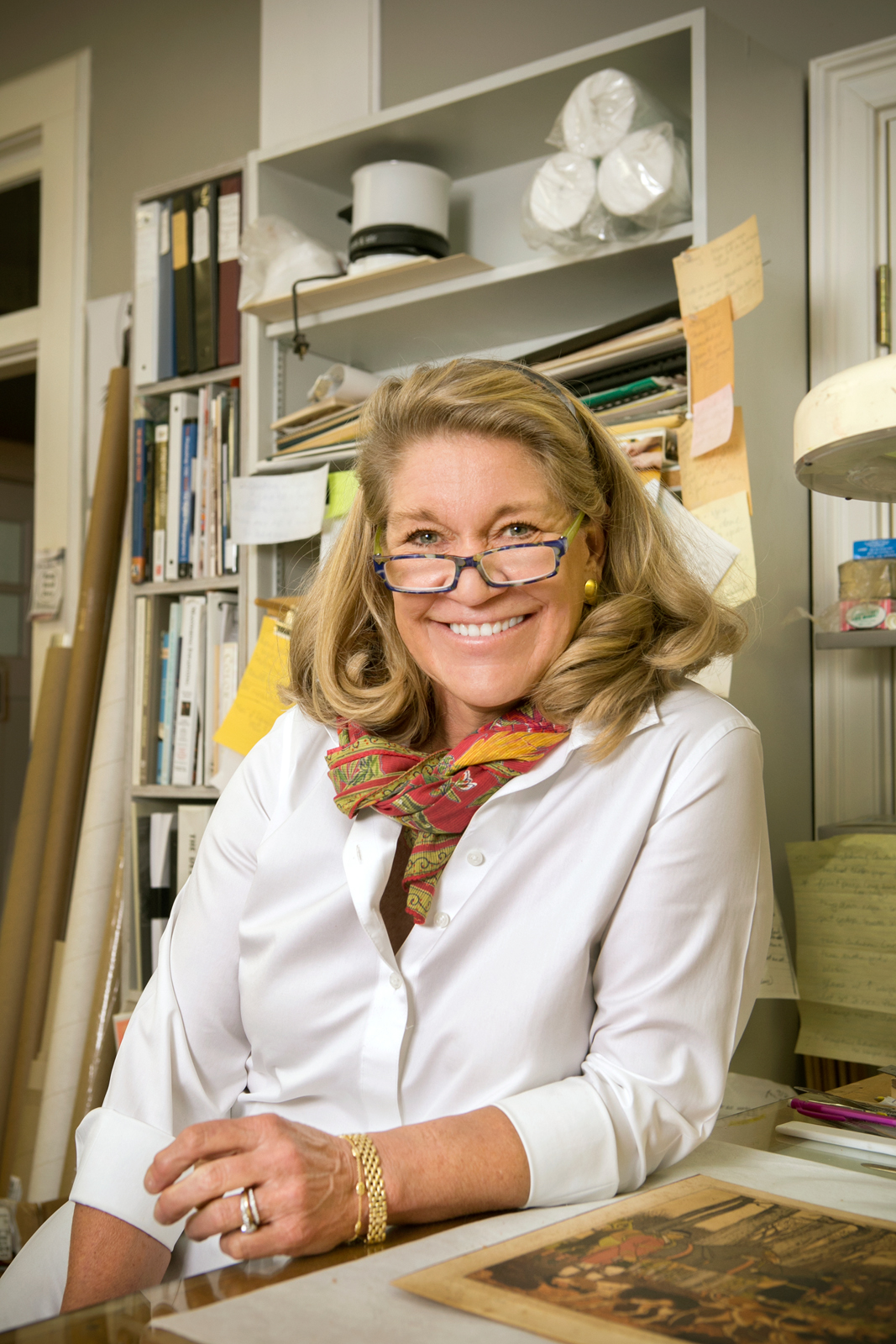
“Art is not what you see, but what you make others see.” ~ Degas
Beauty is indeed in the eye of the beholder. While an abstract Picasso appeals to one enthusiast, a Manet depicting realism might be a favorite for another. That subjective beauty is at the heart of what makes art so important and precious to collectors. A painting can tell two people completely different stories and evoke distinct emotions. Artwork brings life to a dull wall and tells stories of those who created it. That’s partly why conserving these pieces of history, these storytellers, is critical to maintaining their value.
Preserving and conserving art are different — yet related — practices, both vital to the long-term life of artwork. “Preservation is an important concept, in that proper storage and display will minimize damage and can eliminate the need for conservation,” says Alice Perrit, owner of House of Frames and Paintings, Inc., more familiarly known to Columbia residents as HoFP Gallery. “Everything, including all art, degrades with oxidation, but providing a proper environment is the best defense as it can even minimize damage caused by disasters, such as fire or flood.”
“Basically by conserving your art in taking care of it, you can prevent damage. If damage does occur, a conservator steps in and does a restoration treatment. Conservation prevents damage; restoration treatment repairs the damage,” says Ginny Newell, owner of ReNewell, Inc. Fine Art Conservation. She has been restoring art for nearly 35 years, offering advice on preventative steps clients can take to conserve their art and prevent damage.
“I’m often asked if restoring art decreases its value,” says Ginny. “The decrease in value happens when the art is damaged, not when it comes to me. By then, the devaluation has already occurred. Art that is no longer in pristine condition never has its full value.”


Thanks to Ginny’s years of experience and her vast expertise, many pieces of damaged art have been restored. The act of restoring is certainly not a simple one. It is a combination of chemistry, art history, and applied art — combined with integrity, light-handedness, and good judgment. It is a chemical process of removing embedded grime and oxidized varnish without harming the paint layer, and then there is structural repair to the canvas or paper, if needed. “It’s important to separate the artist’s original work from the conservator’s work,” says Ginny. “A conservator is not trying to alter or disguise anything in the original. You want it integrated, but separate.”
Ginny fills in anywhere the original paint is lost. She does not enhance the image or change it; instead, she strives to return it to its original state as closely as possible. Her efforts require more chemistry than art in many cases. She is often tasked with removing embedded surface grime, smoke, and oxidized varnish. “I have to know all of the layers of the art, what pigments are included, and from what period it was created,” adds Ginny. She does this all from a well-equipped lab, where she carefully examines each piece of art prior to giving the client a treatment proposal.
Expertise like Ginny’s is critical to the Columbia Museum of Art, which must care for the thousands of works in its collections. Will South, Ph.D., chief curator at the museum, works with a number of conservators, each with a specialty, such as sculpture, fabric, wood, or paintings. “When a work of art is going on view, we make sure everything is in tip-top shape,” says Will. “There might be some easy fixes, but sometimes a painting has been scratched or has never been restored and has a host of physical problems, such as holes in the art. These are not such an easy fix. A work of art can take a long time to repair. If we get a loan request and do not have sufficient time to conserve that work, we have to deny the request. We can’t show an artist’s work in a bad light.”
No art lasts forever. It will eventually decay. Much of an object’s condition depends on what it has been through. “A ceramic pot buried beneath the ground for 3,500 years can come up looking pretty good,” says Will. “A drawing left out in the rain is probably completely destroyed. In a museum collection, you find a wide variety of conditions from pristine to irreparable.” Because of this, the museum prioritizes what is restored or repaired first. Again, the museum is responsible for showcasing the piece in its best possible light. The art needs to look the way it did when it was made, as much as that is possible, so that visitors to the museum can experience the object in the way it was meant to be viewed.
“People want experiences in their lives,” says Will. “They want exotic food, engaging conversation, unpredictable adventures. They also want authenticity. That food should not be synthetic; the conversation should be honest; that adventure should be real. Conservation allows museums to provide people with authenticity. It restores objects that have suffered damage or decay to their original, or close to it, appearance.”

Will explains that when someone stands in front of the Mona Lisa, they want to see what Leonardo saw, to experience the physical culmination of years of highly skilled work. “They don’t travel all the way to the Louvre to see a 3-D computer simulation of the Mona Lisa, however close that replica may be,” he continues. “People want to identify with the maker and the made, to feel something that arises from direct interaction. Conservators help make that possible. They preserve the objects that make up our culture.”
Those objects can evoke the deepest of feelings within a person. The goal is not to view a painting and have its flaws brought to one’s attention. The goal is to view the piece and be transported in one’s own imagination. This science of conservation enables people this ability.
The Columbia Museum of Art was recently tasked with restoring a portrait of Philip IV by the Spanish artist Juan de Pareja. Pareja was born enslaved in 17th century Spain and grew up to be the studio assistant to Velasquez, who was court painter to Philip IV. “Pareja eventually earned his freedom in part through his skill as a painter,” says Will. “It’s a great story. There are only 10 paintings by him in the world; one is in the Prado in Spain, another in the Hermitage in Russia and one in Columbia.”
The CMA’s portrait was given to the museum in 1950 as a Velasquez, but research later revealed it was a Pareja. The painting had been badly overpainted, while also suffering from paint loss and discoloration. “In short, it was a real mess,” adds Will. The museum wanted to resurrect the painting for a new reinstallation slated for later this year. The painting had not been on the walls for years because of its condition. The museum brought in a conservator who specializes in 17th century European paintings. “The work took two years and a considerable amount of money to complete. Now, the painting glows with a surface unmarred by past awkward attempts at restoration,” Will says. “We will have the painting on the wall and will be able to share the incredible story of an artist who started his career as a slave and ended it as a free man, with his art-making at the center of his life.”
Ginny also recently had an opportunity to work with Will on restoring a valuable piece of art. The museum purchased a Henrietta Deering Johnston (1674-1729) piece at an auction in New York. Johnston is the earliest recorded female artist and the first known pastelist working in the English Colonies. A small pastel (circa 1712) of a woman’s bust had a terrible stain around the image. Because of the condition of the artwork, the piece was often overlooked at auctions. Will had faith that the art could be restored and called on Ginny’s expertise to do just that. “I reached out to my colleagues to confer on the project, as I often do, and then I came up with a treatment plan,” says Ginny. “Lo and behold, I did fix it, and they now have a jewel of a piece of art.”
Ginny holds to two tenets in her work. First, do no harm, and second, try to make all treatments reversible. She does not want to permanently alter the original art. If a painting has lost a lot of paint, Ginny will consolidate and clean the piece, put an isolating coat of varnish on it, fill the loss and in-paint, and then add a final coat of varnish. Her in-painting is sandwiched between two layers of the varnish, for reversibility now and in the future. “In the grand scheme of things, art conservation is very new, starting in earnest around the mid-1800s and changing as time goes by. The emphasis now is on stabilization just in case there is a better technique developed later, and you want your work to be reversed so the new and improved way can be applied,” she says.

While art preservation can help to improve the most impressive of pieces, it is not limited to the Renoir, the Matisse, the Picasso. It also works for the family heirloom that has been passed down from generation to generation or the portrait of the grandfather who served in World War I. Those pieces are far more precious to families than other priceless works of art; therefore, art and heirloom owners must take the appropriate steps to conserve their works.
“Each work of art should be cared for a little differently, but there are two things that all of them need: stable temperature and humidity,” says Alice. “In addition, the art needs protection from chemical contamination from the air and from inferior framing and storage materials. It needs protection from light, especially UV light.”
All light causes fading, referred to as photo-oxidation. Working with a knowledgeable, professional picture framer is the best source for both information and proper care and materials. Storing photos and drawings in acid-free materials is also important. Acidic papers will stain whatever is against them. If one smokes in the home, paintings will get covered in tar, which discolors the art, sometimes permanently. Simple steps can be taken to ensure that beautiful art — whether purchased, created, or inherited — will continue to bring joy and history for many years to come. And, if all else fails, take it to a conservator and watch the magic happen!










